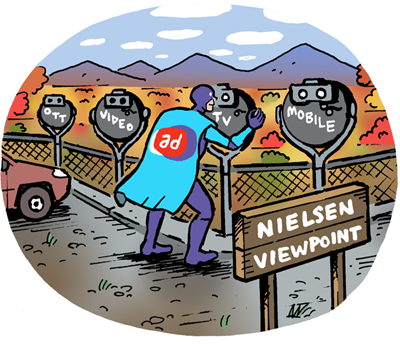The TV measurement conversation is reaching a fever pitch, and Nielsen isn’t staying on the sidelines.
Nielsen intends to bring Nielsen ONE Ads to this year’s upfronts after the ratings giant’s cross-screen measurement platform finally hit the market in January.
And, yes, Nielsen still plans to measure TV ads using its good ol’ audience panels. But this time, it’s also filtering big data sets into that equation to improve measurement for TV campaigns that use more granular targeting.
This year, Nielsen’s measurement methodology is the same, but the data inputs will be different, Karthik Rao, CEO of Nielsen’s audience measurement division, told AdExchanger. (Audience measurement is one of three business units after Nielsen’s recent reorg. The other two are its analytics and Gracenote divisions.)
Specifically, Nielsen is leaning on automatic content recognition and set-top box data to measure TV viewership.
ONE step at a time
Nielsen transacts media using its C3 and C7 metrics, which are averages of TV commercial time over the course of three and seven days, respectively. Nielsen uses these averages to value specific dayparts, including primetime spots.
But three to seven days is a lifetime in the new world of alternative measurement.
Nielsen introduced second-by-second viewership and census-level data into its Nielsen ONE Ads dashboard this year. But that data isn’t ready to be transacted on and can only be used for planning purposes.
To tap into bigger data sets, Nielsen’s first step is to filter more viewership information into the core C3 and C7 metrics it uses for transaction. “Our plan is to build C3 and C7 metrics that marry audience panels with ACR and set-top box data,” Rao said.
Nielsen has already been using some ACR as part of its local TV measurement for about three years. But now, Rao said, ACR will be part of Nielsen’s national ratings, too.
Operation currency
A wider array of viewership data at a more granular level should make Nielsen’s C3 and C7 metrics more accurate and appealing to marketers.
And, for what it’s worth, this gradual move toward big data aligns with how most video currencies should work to fit into transaction workflows that already exist between buyers and sellers with minimal disruption.
“What we’re doing right now is working directly with clients to get them more comfortable with C3 and C7 that’s powered by big data,” Rao said.
The “underlying plumbing is the same,” he said, but clients will still have to make adjustments to their forecasting models to account for new and different data, which may take (yet more) time.
ACR(ms) race
Nielsen is far from the only measurement vendor that’s talking about ACR. Just about everyone in the TV industry right now is clamoring to get their hands on it.
TV measurement is muddy without solid standards, and ACR can help level set some of the noise with more exact, one-to-one ad exposure data.
Just like other TV measurement vendors, including iSpot and VideoAmp, Nielsen licenses ACR data from Inscape, Vizio’s data subsidiary.
But Nielsen stands out in that it also gets ACR from Roku.
Nielsen’s Gracenote business used to have ACR tracking technology, which it sold to Roku in 2021. When that sale happened, Rao said, the two companies entered a strategic partnership that allows Nielsen to access and use the ACR data Roku collects from smart TVs with its operating system.
For the most part, ACR providers work as walled gardens in that they only share ACR for the purpose of targeting and measuring media within their own domains and not across platforms.
The fact that most ACR data lives behind garden walls puts currency providers in a more difficult position to get buyers the cross-platform measurement and show-level transparency they’re demanding. But because Nielsen gets ACR from two major content distributors, it claims to have twice the viewership data coverage as its competition, according to Rao.
Nielsen also licenses set-top box data from DirecTV and DISH.
Accredit where accredit is due
Big data aside, Nielsen has another item at the top of its to-do list: regaining its Media Rating Council (MRC) seal of approval.
When the MRC revoked accreditation of Nielsen’s local and national TV ratings in 2021, alternative measurement providers began their race to replace the currency incumbent.
But Nielsen is hard at work with the MRC to win back its accreditation.
Based on the MRC’s latest batch of feedback, Nielsen put together empirical research that demonstrates the company’s improvements in key areas, including cutting down on the amount of time it takes to respond to disruptions, such as homes in Nielsen’s panel with a meter reading that isn’t working properly.
This research is currently undergoing an audit to determine how much progress Nielsen has made.
Nielsen had originally hoped to wrap up this process by late last year, Rao said, but “we feel pretty good about how much we’ve shortened our list of what could be considered noncompliance.”
Be upfront
Rao also said Nielsen is on track to meet its self-imposed deadline to have Nielsen ONE ready to be used as a currency by 2024.
Nielsen isn’t the only one with that deadline. The new joint industry committee (JIC) of programmers, made up of Paramount, Warner Bros. Discovery and TelevisaUnivision (among others), is working to finalize its standards for video currencies by 2024.
But Rao hedged on the question of whether Nielsen is or will be working with the JIC when it comes to ironing out basic standardization.
“You can conclude whether that [deadline] is a coincidence or not,” he said.
Although Rao said he doesn’t “expect dramatic shifts” in how the upfronts play out this year, “the world of currency measurement is very turbulent right now.”
There’s still a lot left for the industry to do, he said, and “it will be a long journey.”

















